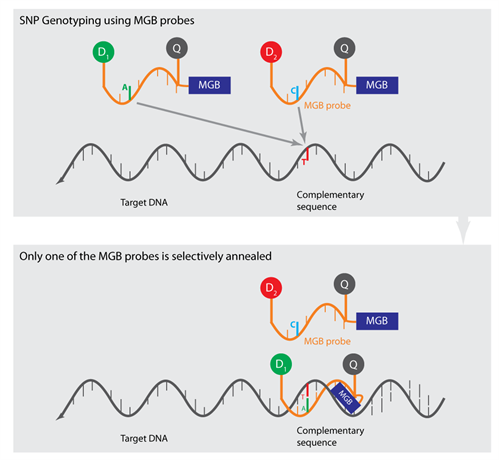MGB molecule in real-time PCR
A probe containing a MGB molecule forms an extremely stable duplex, resulting in a significant increase in its melting temperature (Tm). Therefore, short probes (down to 13 bases) can be used in real-time PCR. Two prominent use of MGB probes are for gene expression & SNP genotyping
Gene Expression analysis:
The annealing of the double-stranded DNA with the MGB probe and other primers leads to the formation of duplexes. At this point the fluorescence of the dye at the 5'-terminus of the MGB probe is quenched by the MGB-Eclipse quencher.

Figure 1: Gene Expression analysis
Primer extensions of the forward and reverse primers are carried out by the taq polymerase. When the taq polymerase encounters the MGB probe, its 5' nuclease activity leads to the cleavage of the probe and, consequently, the separation of the fluorescent dye into the solution. Since the dye in solution is not in the immediate proximity of the quencher, significant enhancements in the unquenched emission signal are observed. The levels of the target DNA can be measured by monitoring the enhancements in the flourescent signal with each new PCR cycle.
Allelic discrimination by selective annealing
Single nucleotide polymorphisms, also called SNPs (or “snips”), are a common type of genetic variation. Each SNP represents a difference in a single DNA base within a sequence—e.g., replacement of a 'G' witgh a 'T'. MGB probes can also be used to identify such SNPs or to identify the levels of different alleles within the strech of DNA. Allelic discrimination is achieved by the selective annealing of the custom sequences of the MGB probes.

Figure 2: SNP genotyping